Student loans are a critical tool for millions pursuing higher education, but navigating repayment and debt relief can feel overwhelming. In 2025, changes to federal policies, repayment restarts, and new forgiveness programs make understanding your options more important than ever. This guide breaks down types of student loans, repayment strategies, and updated relief opportunities to help you make informed decisions. Whether you’re a current borrower or preparing for future debt, these insights will empower you to manage student loans effectively and avoid common pitfalls.

Understanding Student Loans: Types, Terms, and Eligibility Criteria**
Student loans fall into two categories: federal and private. Federal loans, like Direct Subsidized and Unsubsidized loans, offer fixed rates and income-driven repayment plans. Subsidized loans are need-based, with the government covering interest during school, while unsubsidized loans accrue interest immediately. Private student loans, offered by banks or credit unions, require credit checks and often have variable rates. Eligibility for federal loans depends on FAFSA submissions, while private loans rely on creditworthiness. Understanding these differences ensures you choose the best option for minimizing long-term debt.
How to Apply for Federal Student Loans: A Step-by-Step Guide**
To apply for federal student loans, start by completing the Free Application for Federal Student Aid (FAFSA). This form determines eligibility for grants, loans, and work-study programs. Submit the FAFSA by June 30th annually, using tax returns and asset records. Once processed, your school will send a financial aid offer detailing loan amounts. Accept only what you need to reduce debt. Federal loans require a Master Promissory Note (MPN) and entrance counseling. Missing deadlines could forfeit aid, so prioritize FAFSA submissions early each year to maximize funding opportunities.
Private Student Loans: Pros, Cons, and How to Compare Lenders**
Private student loans fill gaps when federal aid falls short, but they lack borrower protections like income-driven repayment. Pros include higher borrowing limits and competitive rates for strong credit. However, variable rates can spike, and approval often requires a cosigner. Compare lenders like Sallie Mae, Discover, and SoFi by reviewing APRs, fees, and repayment flexibility. Check for autopay discounts or cosigner release options. Always exhaust federal loans first—private loans should be a last resort due to rigid terms and limited hardship support.
10 Smart Ways to Manage Student Loan Repayment After Graduation**
Post-graduation, prioritize organizing loans by type and rate. Enroll in autopay for a 0.25% interest discount. Federal borrowers should explore income-driven repayment (IDR) plans, capping payments at 10% of discretionary income. Deferment or forbearance pauses payments during unemployment, but interest still accrues. Refinancing high-rate private loans can save thousands, but federal borrowers lose forgiveness eligibility if they refinance. Allocate windfalls (e.g., tax refunds) to principal payments. Use the Debt Snowball or Avalanche method to tackle smaller or high-interest loans first.
Student Loan Forgiveness Programs: Are You Eligible?**
Federal loan forgiveness programs offer relief for qualifying careers. The Public Service Loan Forgiveness (PSLF) program discharges remaining debt after 120 payments for government or nonprofit employees. Teachers in low-income schools may qualify for up to $17,500 in forgiveness. The Biden administration’s SAVE Plan, launching in 2025, reduces monthly payments and stops interest growth if payments are made on time. To apply, submit employment certifications annually and ensure loans and repayment plans qualify. Note: Private loans are ineligible, and scams promising instant forgiveness are rampant—always verify programs via StudentAid.gov.
Refinancing Student Loans: When It Makes Sense (and When It Doesn’t)**
Refinancing combines multiple loans into one with a lower rate, ideal for private loan borrowers with strong credit. However, federal borrowers risk losing access to IDR plans and forgiveness by refinancing. Evaluate refinancing if rates drop significantly or your credit score improves. Compare offers from lenders like Earnest or Laurel Road, weighing fixed vs. variable rates. Avoid refinancing if you’re pursuing PSLF or anticipate financial instability. Consolidation (different from refinancing) simplifies federal payments but doesn’t lower rates.
How to Avoid Student Loan Default: Tips for Financial Stability**
Defaulting on student loans devastates credit scores and triggers wage garnishment. Avoid this by contacting your lender immediately if you miss payments. Federal borrowers can switch to IDR plans or request deferment. Prioritize loans with the highest rates and cut non-essential expenses to free up cash. Build an emergency fund covering 3–6 months of expenses. Use apps like Mint or YNAB to track spending. If overwhelmed, consult a nonprofit credit counselor. Communication is key—lenders often offer temporary hardship programs to keep accounts in good standing.
The Hidden Costs of Student Loans: Interest, Fees, and Long-Term Impact**
Beyond principal balances, student loans accrue interest daily. Unpaid interest capitalizes (gets added to the principal), increasing long-term costs. Federal loans charge 1–4% origination fees, deducted upfront. Private loans may include late fees or prepayment penalties. Over 10–25 years, interest can double or triple the amount repaid. Use the StudentAid.gov calculator to project total costs. Minimize interest by paying extra monthly or targeting high-rate loans first. Delaying repayment during school? Make interest-only payments on unsubsidized loans to avoid capitalization.
Student Loans and Credit Scores: Building Credit While Paying Off Debt**
Timely student loan payments boost credit scores by demonstrating reliability. Late payments, however, hurt scores and stay on reports for seven years. Federal loans offer grace periods, but private loans may require immediate repayment. Keep credit utilization below 30% and monitor reports via AnnualCreditReport.com. If loans strain your budget, refinance or adjust repayment plans instead of missing payments. Mixing installment loans (like student debt) with revolving credit (e.g., cards) diversifies your credit profile, further improving scores.

2025 Student Loan Updates: New Policies, Deadlines, and Relief Opportunities**
In 2025, federal loan repayments resume after a pandemic-related pause. The Biden administration’s SAVE Plan replaces REPAYE, lowering payments from 10% to 5% of discretionary income. A one-time Account Adjustment credits past periods (e.g., deferment) toward forgiveness. The Supreme Court blocked broad debt cancellation, but targeted relief for defrauded borrowers continues. Stay updated via StudentAid.gov and prepare for repayment by updating contact info with loan servicers. Missed payments won’t penalize credit until September 2024, but interest resumes immediately.
Conclusion**
Managing student loans requires proactive planning, from choosing the right loan type to optimizing repayment strategies. Federal programs like IDR and PSLF offer safety nets, while private loans demand careful comparison. Stay informed about 2025 updates, prioritize high-interest debt, and explore forgiveness eligibility. By budgeting wisely and leveraging available resources, you can reduce financial stress and achieve long-term stability. Remember, student loans are an investment—manage them strategically to maximize returns on your education.
FAQs*
Can I qualify for loan forgiveness with private student loans?**
No. Only federal student loans are eligible for programs like PSLF or Teacher Loan Forgiveness.
What’s the difference between deferment and forbearance?**
Deferment pauses payments and stops interest on subsidized loans; forbearance pauses payments but interest accrues on all loans.
How does refinancing affect my credit score?**
Refinancing triggers a hard inquiry, temporarily lowering your score, but timely payments can improve it long-term.
What happens if I miss a student loan payment?**
Late payments incur fees and hurt credit scores. Federal loans enter default after 270 days; private loans default sooner.
Are parent PLUS loans eligible for income-driven repayment?**
Yes, through the Income-Contingent Repayment (ICR) plan, but payments may be higher than standard plans.
Can I discharge student loans in bankruptcy?**
Rarely. Borrowers must prove “undue hardship,” a high legal barrier.
How do I find my loan servicer?**
Log into StudentAid.gov to view servicer contact details for federal loans.
What’s the grace period for federal loans after graduation?**
Six months for most loans, excluding Perkins loans (nine months).
Can I pay off student loans early without penalties?**
Federal and most private loans allow early repayment without fees. Check your lender’s policy.
How does the SAVE Plan differ from other IDR plans?**
SAVE reduces payments to 5% of discretionary income (vs. 10%) and prevents unpaid interest from growing.